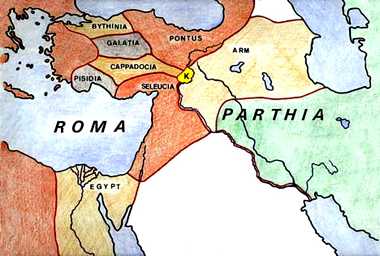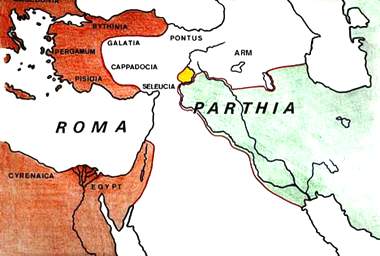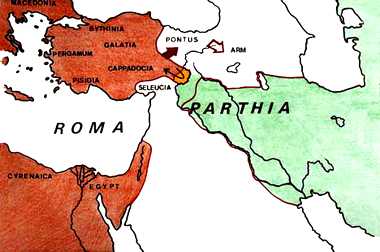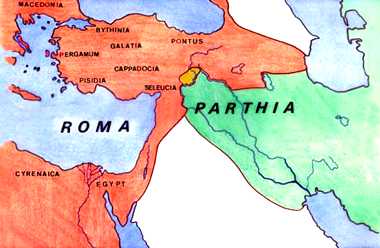After the Romans had obtained a foothold in Western Turkey, they captured one by one, the kingdoms of Asia Minor, Bithynia, Pisidia, Galatia and Cappadocia.
After Pergamum they captured around 80 B.C. Bithynia and Pisidia. At the same time the Parthians had reached the borders of Kommagene.
Around 70 B.C., the Romans destroyed their greatest enemy, the kingdom of Pontus. Next, the Romans overran the mighty ally of Pontus, the kingdom of Armenia. To complete their conquest, the Romans continued swiftly to the last independent kingdom, Kommagene. Like a steam roller, they invaded the small country.
In 69 B.C. the capital of Kommagene, Samosata, was besieged. Then the unexpected happened. The Roman war machine was stopped. To their horror, the Roman soldiers were bombarded with an alien substance, unknown outside Kommagene. A Roman historian Plinius recorded: “A soldier who is touched by it, burns with all his weapons”. Obviously the fear caused by this weapon (naphtha?) was tremendous.
Samosata could not be captured. There was a personal meeting between the Roman consul Lucullus and King Antiochos. We do not know what they discussed, but it resulted in the withdrawal of the Roman legions.
Still, the situation remained tense for Kommagene, as it was caught between two giants. On one side, the imperialistic, warlike Romans and on the other, the powerful realm of the Parthians.
Map of Asia Minor 100 B.C. : Pergamum, Bithynia, Galatia, Cappadocia, Pisidia, Pontus, Armenia, Seleucia, Kommagene, Parthia, Roma.

Map of Asia Minor 80 B.C. : Galatia, Cappadocia, Pisidia, Pontus, Armenia, Seleucia, Kommagene, Parthia, Roma.

Map of Asia Minor 70 B.C. : Pontus, Armenia, Seleucia, Kommagene, Parthia, Roma.

Map of Asia Minor 60 B.C. : Kommagene, Parthia, Roma.

In 64 B.C. the Romans continued their conquests. The remnants of the Seleucid state were swept away and absorbed into the province of Syria. By this time Rome had subjugated all the independent states of Asia Minor, except for Kommagene.
Kommagene even profited from the fall of the Seleucid state, by gaining a limited extension of territory. From the strategic position of Kommagene, it was obvious that sooner or later Rome had to conquer it or halt its eastward expansion.
Therefore, Antiochos reinforced his ties with the Parthians by giving his daughter, Laodike, in marriage to the Parthian king. They begat a son named Pakoros. He was heir to the throne and the favourite of his father.
The wars in Asia Minor continued. In 53 B.C. the Parthians defeated the Romans and conquered Syria. Now, the subjugated kingdom of Pontus felt strong enough to rebel against the Roman usurper. Julius Caesar marched to Asia Minor and suppressed the rebellion. On the occasion of this victory, Caesar spoke the famous words “I came, I saw, I conquered”.
After the assassination of Julius Caesar, the Roman Empire was divided among his successors. Marcus Antonius received the east and Octavianus the west. Marcus Antonius held court at Tarsus, where his beloved Cleopatra kept him company. Even Julius Caesar had succumbed to the beauty of the queen of Egypt and so had Marcus Antonius.
Marcus Antonius defeated an army of the Parthians in 38 BC. He killed Pakoros, the Parthian crown prince. His father, the king of the Parthians, and his mother, maybe Laodike, were full of grief. When the survivors of the battle fled to Kommagene, Antiochos gave them protection. He refused to yield the fugitives to Marcus Antonius. Instead, to avoid war, Antiochos offered the Roman 1000 talents. An amount equivalent to more than 25 tons of silver.
Marcus Antonius now saw a possibility to take possession of the gold and silver of Kommagene, a land famed for its wealth. He refused the offer of Antiochos and demanded the entire treasure of Kommagene. Antiochos refused.
Marcus Antonius, saw this as a grave insult by a petty local chieftain. He ordered his legions to invade Kommagene immediately. He himself stayed at the court of Tarsus in expectation of good tidings. In the meantime, he enjoyed the company of his beloved Cleopatra.
Unfortunately, the good tidings did not arrive. On the contrary, he received a message that the siege of Samosata was at a standstill. Marcus Antonius was forced to say farewell to the good life at the court. He left Tarsus and took personal command of his legions. To avoid failure, King Herod of Judea was summoned to his aid. Marcus Antonius felt confident that the task would soon be accomplished.
Perhaps the story went like this: As the siege of Samosata continued the Kommagenian soldiers were amassing in the outlying districts of Kommagene. Loyal to the call of their king, every civilian who could wield a weapon reported for duty.
When their numbers were sufficient, they began an attack on the supply columns of Marcus Antonius. Soon the Romans were cut off from their supplies. Marcus Antonius had to send out his cavalry to re- establish his provisions.
This was what the military council of Kommagene had counted on. Now the time had come for the dreaded elite corps of Kommagene, the heavy armoured cavalry, to move in.
Horse and rider were protected by armour of black steel, which made them almost invincible. They numbered only a few hundred riders, but when they attacked, no enemy could stop them. This steel hammer was the pride of Kommagene.
In the mist of early morning they awaited the Romans, not yet discovered by Roman scouts. The horses nervously kicked the ground with their hooves. Suddenly, the shrill sound of the trumpets rent the silence. On that signal the riders advanced. When the trumpets sounded a second time, the Kommagenian riders glided into gallop. The earth trembled. Like rolling thunder they approached the Romans. Hastily, the Roman cavalry closed their ranks to withstand the first blow. It was too late for the surprised Romans to retreat. With a tremendous blow the heavily armoured riders clashed onto the Romans.
The light armoured Romans were felled like skittles. The Kommagenian riders ploughed through their ranks. Cold bloodedly, the disciplined Romans pulled themselves together. Counting on their far greater numbers, they tried to surround the small iron force.
Again the trumpets sounded shrill. From behind the elite corps, like the wings of an eagle, two regiments of mounted archers swarmed out on both sides. A barrage of arrows was shot into the ranks of the Romans. Their light armour was insufficient protection against the piercing steel arrows and many of them were injured. While the heavily armoured cavalry continued to beat the Romans into the arms of the Kommagenian archers, the archers systematically shot them off their horses. Panic arose and the Romans broke their ranks. First they lost their heads and then their lives.
At the end of the day, Marcus Antonius had lost his cavalry. Caught between the walls of Samosata and the Kommagenian army, he was changed from the besieger into the besieged.
Of course we do not know this has happened in reality, but whatever has happened, Marcus Antonius was forced to relinquish the siege of Samosata. His ally, Herod, did not wait for the final outcome and had already returned to his kingdom, Judea. Empty handed, Marcus Antonius had to retreat. The magnanimous Antiochos gave him 300 talents to soften the blow. In exchange, Marcus Antonius had to deliver a renegade to Antiochos. Antiochos insisted on this, as he hated faithlessness and treachery.



